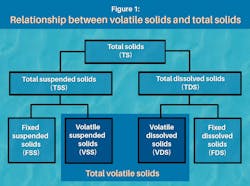Volatile solids are the portion of the total solids representing the organic matters, that as the name implies, can be volatilized, when subjected to high temperatures. Notably, “volatile” in this context does not mean that these solids rapidly evaporate and rather it means that they have the ability to be volatilized (i.e., converted to gas) when they are heated at high temperatures, specifically at 550oC ± 50oC.
After total solid is heated at a high temperature, the portion that remains is the total fixed solids and the portion that is lost is the total volatile solids. Therefore, total solids is composed of several solid fractions, including total volatile solids, with each solid fraction possessing their unique characteristics, as explained in the next section.
The relationship between the solid fractions in wastewater
Figure 1 (above) illustrates the relationship between the solid fractions in a wastewater sample.
TS (total solids) = TSS (total suspended solids) + total dissolved solids (TDS)FSS (fixed suspended solids) and VSS (volatile suspended solids) are components of TSS (total suspended solids). Volatile dissolved solids (VDS) and fixed dissolved solids (FDS) are components of TDS (total dissolved solids).
TVS (total volatile solids) = VSS (volatile suspended solids) + VDS (volatile dissolved solids)What is an example of a volatile solid?
Volatile solids in wastewater are also called organic solids and volatile matter. It is the portion that is lost during heating. Volatile fatty acids and volatile sulfur compounds are some examples of volatile solids in wastewater. Methylsiloxanes are examples of volatile solids in sewage sludge.
What is the difference between COD and volatile solids?
Chemical oxygen demand (COD) is a measurement of the amount of oxygen required to oxidize soluble and particulate organic matter in water. It is different than volatile solids (also called organic solids) which are actually chemical compounds that are lost when heated at high temperatures.
The ratio of COD to volatile solids is used to find the amount of oxygen required by the organic matter for decomposition. The higher this ratio is, the more oxygen is required by organic matter for decomposition and vice versa.
In an anaerobic digester, the COD and volatile solids are among the parameters used in the determination of how much biodegradable material is potentially available for the microorganisms in an anaerobic digestion system.
How are volatile solids reduced?
Volatile solids are reduced via ignition at high temperature of 550oC ±50oC. At such a high temperature, the volatile component of the solids is converted to gas. The amount of volatile solids reduced can be calculated using the mass of the volatile solids converted to gas (i.e., destroyed) divided by the mass of the volatile solids loaded.
How do you calculate the reduction of volatile solids?
Because total volatile solids are a component of total solids, the Standard Method 2540B is used to calculate the total volatile solids. In Standard Method 2540B, the wastewater sample is placed in an evaporative oven and the solids that remain behind are weighed to calculate the concentration of the total solids in the wastewater sample.
Following this test, the total volatile solids is then calculated using Standard Method 2540E. The solid resulting from Standard Method 2540B is placed in a furnace set at 500oC ± 50oC. The portion in the sample that is organic combusts and volatilizes and the resulting vapor exits the furnace. The remaining non-volatilized solids are eventually weighed after treatment in a desiccator and this value is used in the calculation for the concentration of the total volatile solids in the wastewater sample.
How do volatile solids affect the strength of sewage?
Volatile solids play a crucial role in the biological oxidation process in wastewater. In the biological oxidation process, the microorganisms use the organic components of the volatile solids as their food source and this results in more microbial biomass and the process produces water and carbon dioxide. This process is also known as digestion. Anaerobic digestion is also used in some cases for the consumption of volatile solids by microorganisms.
However, the amount of volatile solids in wastewater can significantly impact wastewater treatment and thus, arises the necessity of managing volatile solids in wastewater. High levels of volatile solids can lead to an increased production of sludge which in turn can lead to challenges in sludge handling and disposal. On the other hand, low levels of volatile solids can limit the effectiveness of the biological oxidation process because there might not be sufficient organic material to support the growth of the microorganisms.
Management of volatile solids in wastewater
The management of volatile solids in wastewater, other than by biological oxidation, includes sedimentation and chemical treatment.
Sedimentation
In sedimentation, solids depending on their weight, settle to the bottom of the tank. The process is used to remove large and thus heavier volatile solids from the wastewater. However, because some solids are too small or light to settle effectively, sedimentation alone is not sufficient for the management of volatile solids and thus, sedimentation is used along with other processes.
Chemical treatment
In this treatment, chemicals are used to precipitate the solids to make them easier to remove by sedimentation. Some chemicals can also be used to break down the organic component of the volatile solids, thus reducing their volume. However, because chemical treatment can produce by-products which can be challenging to remove, it is used as a secondary treatment method.
About the Author
Saleha Kuzniewski
Saleha Kuzniewski, Ph.D. has authored several publications in the fields of scientific research, biotechnology, and environmental regulations. She is the winner of the 2023 Apex award for publication excellence. She is also the founder of Environmental Remediation & Innovations, LLC. Kuzniewski can be reached at [email protected].


